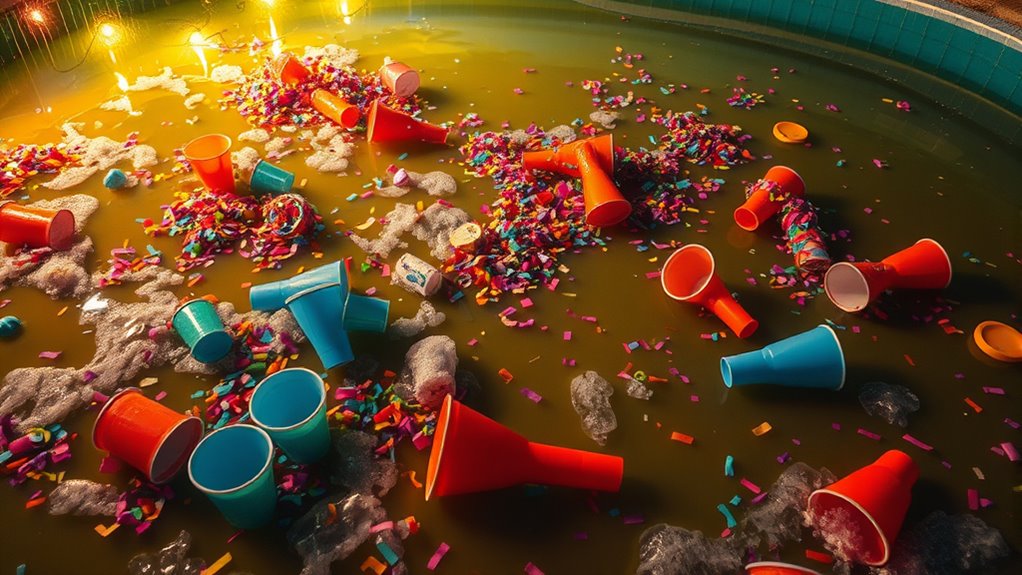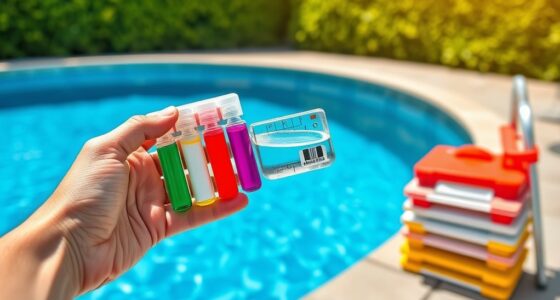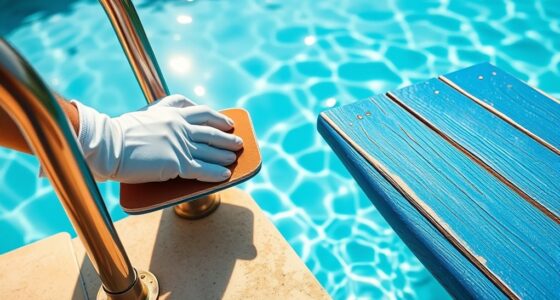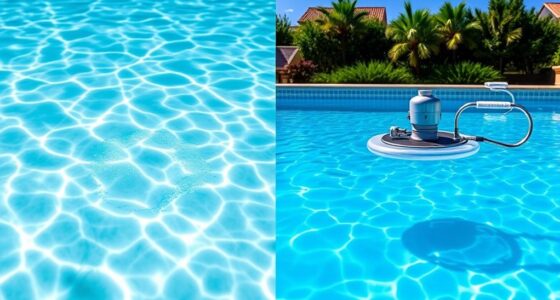After a heavy party, your pool needs quick attention to stay safe and clear. Test the water’s pH, alkalinity, and chlorine levels frequently, then balance them by adding chemicals like sodium bicarbonate or carbonate as needed. Shock the pool with a high dose of chlorine to remove bacteria and algae, and make sure your filtration runs effectively. Keeping up with proper maintenance prevents issues from worsening—continue exploring these steps to keep your pool pristine.
Key Takeaways
- Test and balance water chemistry regularly, focusing on pH, alkalinity, and sanitizer levels, to restore proper conditions.
- Shock the pool with a high dose of chlorine to eliminate contaminants and restore sanitation.
- Clean debris, surface skimming, and maintain filters to prevent buildup of organic matter and bacteria.
- Use algaecides and maintain chlorine levels between 1-3 ppm to prevent algae growth.
- Ensure proper circulation and aeration to stabilize chemical balance and inhibit microbial proliferation.
Assessing the Impact of Heavy Use on Pool Water Quality
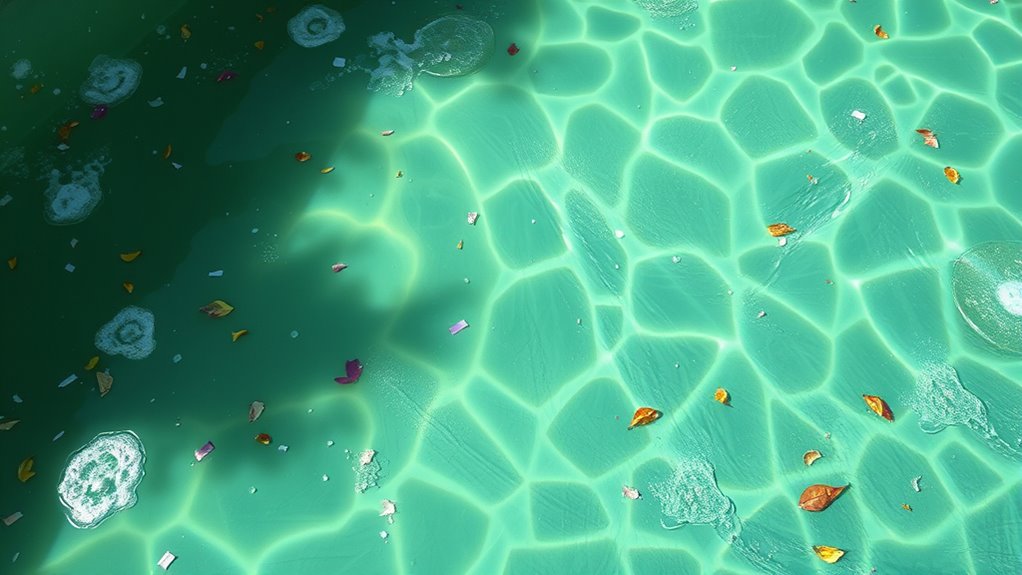
Heavy use of a pool can considerably impact its water quality, often leading to increased contamination and chemical imbalances. When many people swim, they introduce sweat, oils, dirt, and other pollutants into the water. These contaminants can cause cloudy water, foul odors, and an environment where bacteria and algae thrive. Additionally, with frequent use, the chlorine levels can drop quickly, reducing the water’s disinfectant effectiveness. This imbalance can make the pool unsafe and require more frequent chemical adjustments. You’ll also notice that debris, hair, and organic matter accumulate faster, increasing the strain on your filtration system. Monitoring these changes helps you understand how heavy use affects your pool and guides you in maintaining a safe, clean swimming environment. Proper water testing and chemical balancing are essential to counteract these effects and keep your pool inviting and safe for swimmers.
Testing Your Pool’s Chemical Levels Post-Party
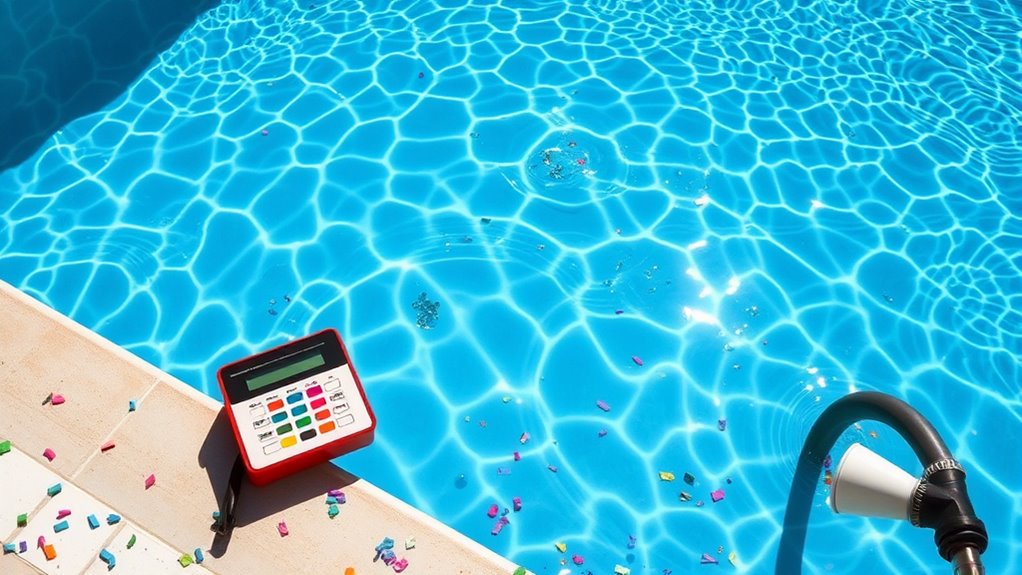
After a lively pool party, testing your water’s chemical levels is essential to guarantee safety and clarity. Proper testing helps you identify any imbalances caused by increased swimmers, debris, or spills. To get accurate results, follow these steps:
- Use a reliable test kit or strips to measure pH, chlorine, alkalinity, and stabilizer levels.
- Collect a water sample from shoulder depth, away from skimmers or return jets.
- Follow the instructions on your testing kit precisely for accurate readings.
- Record the results and compare them to recommended pool levels to determine if adjustments are needed.
- Remember that water chemistry can fluctuate rapidly after heavy use, so frequent testing is advisable. Additionally, regularly checking your pool filtration system ensures it is functioning properly to maintain water quality. Monitoring water circulation helps prevent stagnation and distributes chemicals evenly. Proper circulation is vital for maintaining water quality after heavy pool use. Regular testing and proper maintenance contribute to preventing water imbalance and ensuring a safe swimming environment.
Balancing Ph and Alkalinity After Heavy Swimming
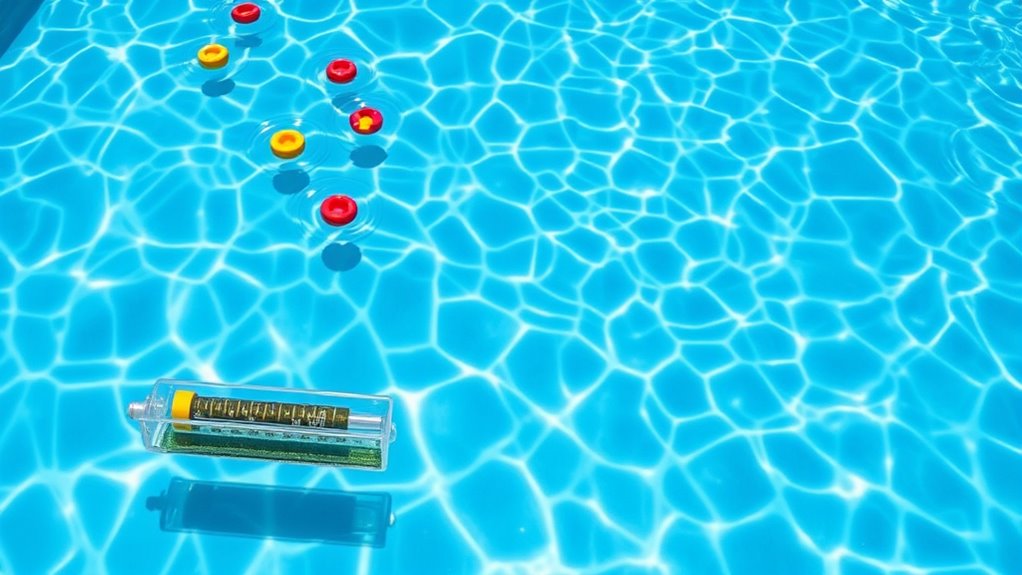
When your pool has seen a surge of swimmers, balancing pH and alkalinity becomes essential to maintain safe and comfortable water conditions. Heavy swimming introduces contaminants and sweat that can lower pH levels and disrupt alkalinity balance. Start by testing your water’s pH and alkalinity with reliable test strips or a kit. If pH drops below 7.2, add a pH increaser like sodium carbonate to raise it. For alkalinity, if it’s too low (below 80 ppm), add alkalinity increaser such as sodium bicarbonate. If levels are too high, consider aerating the water to lower alkalinity naturally. Regular monitoring and adjustments keep your pool safe, comfortable, and ready for more swimmers. Incorporating automated data privacy tools and sensors can help continuously monitor water quality parameters for optimal maintenance. Utilizing testing methods ensures accurate readings and better control over chemical adjustments. Additionally, setting common goal tracking reminders can help you stay consistent with water testing and adjustments for ongoing pool health. Implementing proper circulation practices also aids in maintaining balanced water chemistry by ensuring chemicals are evenly distributed throughout the pool.
Chlorine and Sanitizer Adjustments for Cleanliness
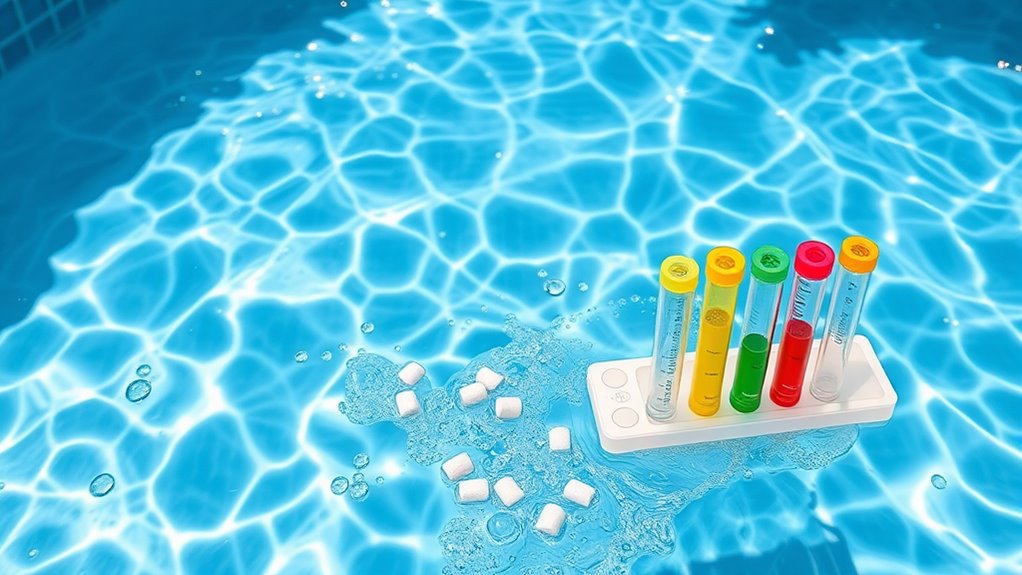
Ensuring proper chlorine levels and sanitizer coverage is key to keeping your pool water safe and clear, especially following periods of heavy use. When guests have been swimming nonstop, it’s essential to boost your sanitizer to combat bacteria and contaminants. Start by testing your chlorine levels—aim for 1-3 ppm—and add enough chlorine to reach that range. Next, verify your sanitizer coverage across the entire pool. Consider the following steps:
- Shock the pool with a high dose of chlorine to eliminate organic matter.
- Maintain a consistent chlorine level with regular testing throughout the day.
- Use stabilizers like cyanuric acid if sunlight is reducing chlorine effectiveness.
- Brush and skim the pool to remove debris and distribute sanitizer evenly.
- Check the pool hours to ensure you’re maintaining proper maintenance schedules and access times for your equipment and supplies. Regular monitoring of filtration system performance can also help optimize water clarity and sanitizer effectiveness. Additionally, maintaining proper water chemistry balance helps prevent issues with algae and bacteria growth. Implementing proper disinfection procedures further ensures the water remains safe and hygienic. Regularly inspecting your equipment and maintaining optimal pool circulation can also improve sanitizer distribution and overall water quality.
This routine helps restore water clarity and keeps your pool safe for future use.
Addressing Bacteria and Algae Growth Risks
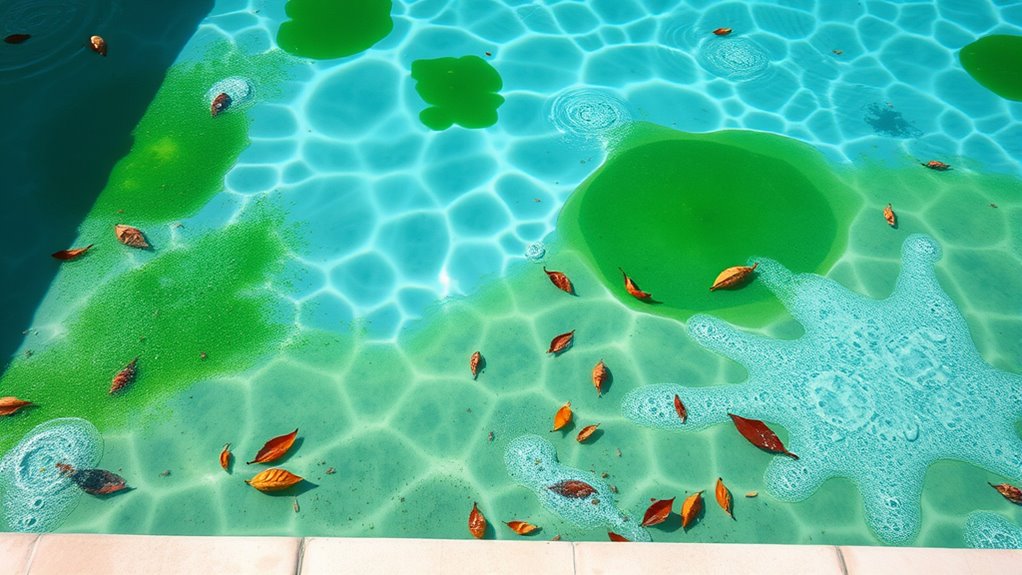
Bacteria and algae can quickly turn your pool into a health risk if you’re not careful. Understanding the main risk factors and how to prevent algae blooms is key to maintaining a safe swimming environment. Effective sanitization methods keep bacteria and algae growth under control, ensuring your pool stays clean and inviting. Incorporating proper filter maintenance can further enhance water quality and reduce the likelihood of contamination. Regularly testing water parameters helps monitor and adjust chemical levels to maintain optimal water balance, which is essential for preventing microbial growth. Using glycolic acid in pool maintenance routines may assist in controlling dead skin cell buildup, ultimately supporting clearer water and healthier pool surfaces. Additionally, selecting a suitable pool sanitization method can help maintain a safe and clean swimming environment.
Bacteria Risk Factors
Poor water circulation and inadequate chemical balance create ideal conditions for bacteria and algae to thrive in your pool. When circulation slows, contaminants settle, and disinfectants don’t evenly distribute. Dual-flush toilet system can help conserve water and reduce excess organic waste from heavy partying, which provides extra nutrients for microbial growth. Improper chemical levels weaken your sanitizer’s effectiveness, allowing bacteria to multiply. High organic waste from heavy partying provides extra nutrients for microbial growth. Without proper maintenance, these factors increase the risk of harmful bacteria spreading. Maintaining proper water quality is essential to prevent bacterial proliferation, especially after heavy use. Additionally, digital literacy programs can help educate pool owners on proper maintenance practices to prevent such issues.
Algae Bloom Prevention
Algae blooms often take advantage of imbalanced pool conditions, especially when circulation slows and chemical levels are off. When the water isn’t properly circulated, nutrients accumulate, providing a feast for algae. If your chlorine levels drop or pH drifts out of balance, algae can quickly take hold. To prevent this, maintain consistent circulation by running your pump regularly, even after heavy use. Keep your chlorine levels at the recommended range, typically 1-3 ppm, and ensure pH stays between 7.2 and 7.6. Shock the pool periodically to eliminate organic contaminants and algae spores. Using algaecides as a preventative measure can also help, but only when chemical levels are balanced. Staying vigilant with your pool chemistry is your best defense against algae blooms.
Effective Sanitization Methods
To effectively prevent bacteria and algae growth in your pool, maintaining proper sanitization is essential. You need to keep sanitizer levels balanced and ensure consistent treatment. First, test your water regularly with a reliable test kit to monitor chlorine or bromine levels. Second, shock your pool weekly with a high dose of chlorine to eliminate contaminants. Third, use algaecides as a preventive measure against algae blooms. Fourth, keep filtration systems clean and running efficiently to remove debris and bacteria. Proper circulation distributes sanitizers evenly and prevents dead spots where bacteria and algae can thrive. By following these steps, you create an environment that’s safe, clear, and enjoyable after heavy use. Consistent sanitization is your best defense against maintaining a healthy, algae-free pool.
Removing Debris and Contaminants Effectively

To keep your pool clean, start by skimming the surface regularly to remove leaves and bugs before they sink. Make sure your filtration system is working properly to trap smaller particles and contaminants. Consistent cleaning and filtration help maintain clear, healthy water.
Skim Surface Debris
Regularly skimming the surface of your pool is one of the most effective ways to remove floating debris and contaminants. It prevents debris from sinking and contaminating your water. To do this efficiently, keep a clean, sharp skimmer net nearby. Use smooth, deliberate motions to gather leaves, bugs, and other debris without displacing water. Focus on these key points:
- Check the skimmer basket frequently to prevent blockages.
- Skim the entire surface, paying special attention to corners and edges.
- Remove debris gently to avoid stirring up settled particles.
- Rinse the skimmer net after each use for ideal performance.
Consistency is key; regular skimming keeps your pool cleaner and reduces chemical imbalances after heavy use.
Use Proper Filtration
Using proper filtration is the next step in keeping your pool clean after skimming surface debris. Make sure your filter system is functioning correctly and running for enough hours each day to trap dirt, hair, and other contaminants. Check the filter pressure regularly; high pressure indicates it’s time to clean or backwash the filter. Keep the filter media clean—whether it’s a cartridge, sand, or DE grid—to guarantee ideal flow and filtration efficiency. Consider running your filter during peak usage times or overnight to continuously remove particles. Using a high-quality filter system helps prevent debris from settling at the bottom and keeps your water clear and inviting. Regular maintenance and proper operation are key to maintaining a healthy, balanced pool environment.
Shocking Your Pool to Restore Sanitation
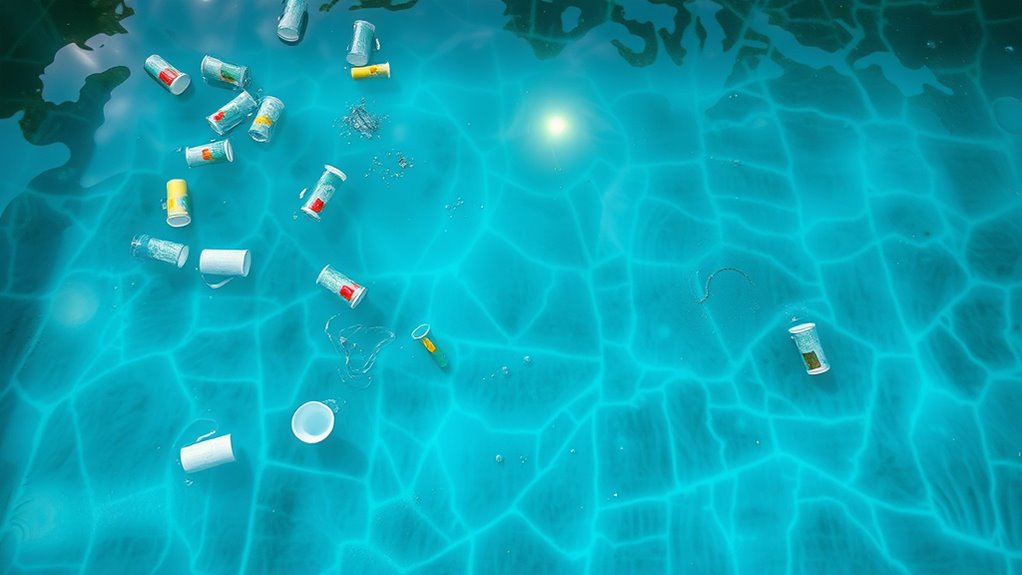
When your pool’s sanitizer is overwhelmed by contaminants, shocking is the most effective way to restore clear, healthy water. It kills bacteria, algae, and organic compounds that regular chlorination can’t handle. To shock your pool properly, follow these steps:
- Test your water to determine how much shock to add.
- Choose a suitable shock treatment, like calcium hypochlorite or sodium dichlor.
- Add the shock evenly around the pool, preferably at dusk to prevent rapid chlorine dissipation.
- Run your pump continuously for 8-12 hours to circulate the chemicals thoroughly.
Shocking your pool after heavy use ensures your water remains safe and inviting. Just remember, always follow manufacturer instructions and avoid swimming until chlorine levels return to normal.
Maintaining Ongoing Pool Chemistry for Future Parties
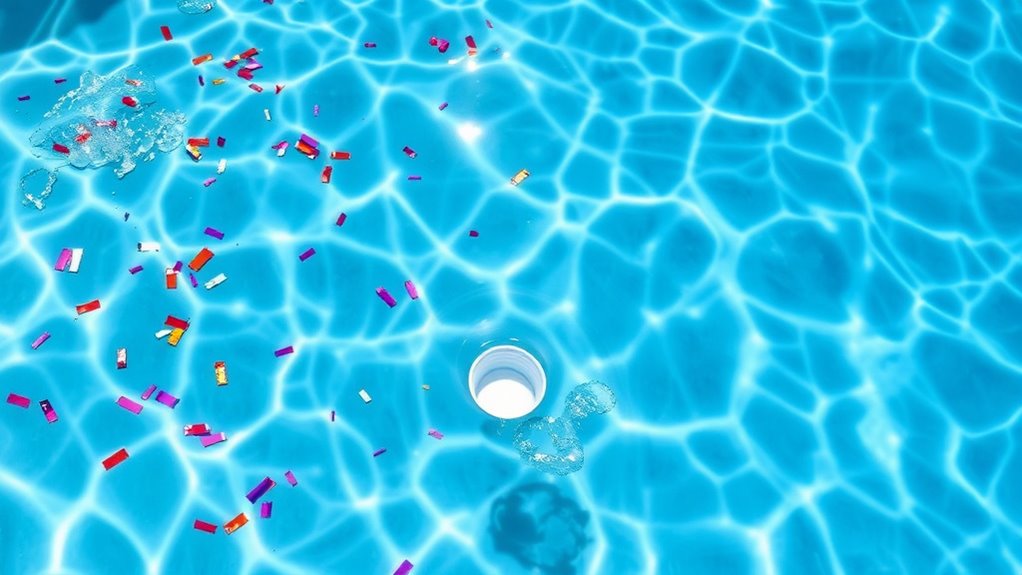
To guarantee your pool stays inviting and safe for upcoming parties, maintaining balanced water chemistry is essential. Regular testing is your first step; check pH, chlorine levels, and alkalinity at least twice a week. Keep pH between 7.2 and 7.6 to prevent irritation and ensure sanitizer efficiency. Maintain chlorine levels around 1-3 ppm to keep bacteria at bay. Add algaecide or stabilizer as needed to prevent algae growth and protect your sanitizer. Shock the pool weekly or after heavy use to eliminate contaminants. Keep your filtration system running continuously to circulate chemicals evenly. Consistent maintenance prevents issues before they start, ensuring your pool remains welcoming and safe for every future gathering.
Frequently Asked Questions
How Often Should I Test My Pool After a Heavy Party?
You should test your pool’s water at least twice a day after a heavy party. This helps you monitor chlorine and pH levels, which can fluctuate with increased use. Use test strips or a tester kit for quick results. Adjust chemicals as needed to maintain safe, balanced water. Regular testing guarantees your pool stays clean, safe, and inviting, even after a lively gathering.
What Are Signs of Chemical Imbalance Caused by Heavy Use?
When you notice signs of chemical imbalance, it’s usually obvious. You might see cloudy water, algae growth, or foam on the surface. Your pool could have a strong chlorine smell even if the water isn’t sanitized properly. You might also notice skin or eye irritation after swimming. These signs indicate your pool’s chemistry is off, and you should test and adjust your chemicals promptly to keep your water safe and clear.
Can Over-Shocking Harm My Pool Equipment?
Think of shocking your pool like giving it a power boost. Over-shocking can harm your pool equipment, just like too much force can break delicate parts. When you add excessive chlorine, it can corrode metal components, damage filters, or cause rubber seals to degrade. To keep your pool in top shape, always follow manufacturer instructions, and avoid overdoing it with chemicals. Proper balancing protects both your pool and its equipment.
How Long Should I Wait Before Swimming Again After Balancing Chemicals?
You should wait until your pool’s chemical levels are balanced before swimming again. Typically, wait at least 4-6 hours after adding chlorine or other chemicals, but it’s best to test the water first. Make sure your pH, chlorine, and other levels are within safe ranges. If you used a lot of chemicals during a party, consider waiting a bit longer and retesting to make certain the water is safe and comfortable for swimming.
What Preventive Measures Can Minimize Contamination During Parties?
Did you know that during a party, a single guest can introduce up to 2 million bacteria into your pool? To minimize contamination, you should encourage guests to shower before swimming and avoid bringing in food or drinks into the pool area. Using skimmers frequently and maintaining proper chemical balance also helps. These steps create a safer, cleaner environment, so everyone can enjoy the water without worry.
Conclusion
Even if your pool’s been heavily used, maintaining proper chemistry is doable with the right steps. Don’t let worries about complex adjustments hold you back—regular testing and quick treatments keep your water crystal clear and safe. A little effort now prevents long-term issues, so you can enjoy future parties without stress. With simple routines, you’ll keep your pool inviting and healthy, no matter how lively your gatherings get.
